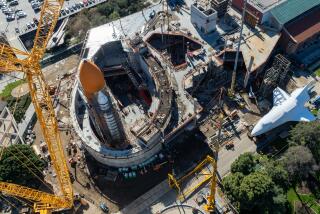Prototype Space Factory May Get Early Retrieval
- Share via
KENNEDY SPACE CENTER, Fla. — The crew of the space shuttle Columbia may need to pick up a prototype space factory early because it is drifting too close to a space telescope, NASA officials said Sunday.
The Wake Shield satellite, which was set free from Columbia on Friday, was not due to be recovered until early Tuesday, but the shuttle may have to fly in and get it early today, Mission Control told the astronauts.
The saucer-shaped space factory has drifted to within 24 miles of the Orfeus-Spas telescope, released Tuesday by the astronauts.
The Wake Shield, a 2-ton, 12-foot-diameter disk, is designed to produce thin, pure semiconductor film that could lead to faster computer chips. It trailed Columbia by about 25 miles on Sunday and the ultraviolet telescope was another 40 miles back.
“We may have to call on you guys to roll with it a bit today,” said spacecraft communicator Bill McArthur after waking the astronauts about 2 p.m. EST Sunday.
“Overnight, we’ve noticed Spas getting just a little bit close to Wake Shield, and I wanted to give you a heads-up that we are looking at the criteria that might require you to go in and do a retrieval at the end of today.”
The five astronauts, who are on the sixth day of a 16-day flight, were expecting to get six hours off on Sunday. If they are instructed to collect the Wake Shield, it will be plucked from orbit by the shuttle’s robot arm at about 2:45 a.m. EST today.
Four of the factory’s seven planned semiconductor manufacturing runs had been completed by Sunday afternoon, and two more could be accomplished even if the shuttle has to collect it early, NASA commentator Eileen Hawley said.
Meanwhile, NASA video transmissions revealed two tiny dings on the shuttle.
The astronauts beamed down pictures showing two marks in a crew cabin window that are similar to the kinds of damage caused in the past by micrometeorites.
Crewman Thomas Jones said the larger pit was about half a millimeter wide. He described the other as pinpoint-sized.
Orbiting at 17,500 mph, even something as small as a grain of sand can damage the shuttle.
More to Read
Sign up for Essential California
The most important California stories and recommendations in your inbox every morning.
You may occasionally receive promotional content from the Los Angeles Times.












